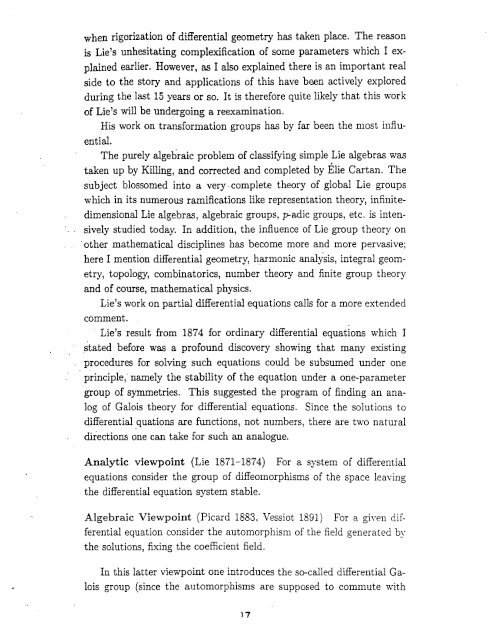Sophus Lie, the mathematician
Sophus Lie, the mathematician
Sophus Lie, the mathematician
You also want an ePaper? Increase the reach of your titles
YUMPU automatically turns print PDFs into web optimized ePapers that Google loves.
when rigorization of differential geometry has taken place. The reasonis <strong>Lie</strong>'s unhesitating complexification of some parameters which I explainedearlier. However, as I also explained <strong>the</strong>re is an important realside to <strong>the</strong> story and applications of this have been actively exploredduring <strong>the</strong> last 15 years or so. It is <strong>the</strong>refore quite likely that this workof <strong>Lie</strong>'s will be undergoing a reexamination.His work on transformation groups has by far been <strong>the</strong> most influential.The purely algebraic problem of classifying simple <strong>Lie</strong> algebras wastaken up by Killing, and corrected and completed by Elie Cartan. Thesubject blossomed into a very complete <strong>the</strong>ory of global <strong>Lie</strong> groupswhich in its numerous ramifications like representation <strong>the</strong>ory, infinitedimensional<strong>Lie</strong> algebras, algebraic groups, p-adic groups, etc. is intensivelystudied today. In addition, <strong>the</strong> influence of <strong>Lie</strong> group <strong>the</strong>ory on'o<strong>the</strong>r ma<strong>the</strong>matical disciplines has become more and more pervasive;here I mention differential geometry, harmonic analysis, integral geometry,topology, combinatorics, number <strong>the</strong>ory and finite group <strong>the</strong>oryand of course, ma<strong>the</strong>matical physics.<strong>Lie</strong>'s work on partial differential equations calls for a more extendedcomment.<strong>Lie</strong>'s result from 1874 for ordinary differential equations which Istated before was a profound discovery showing that many existingprocedures for solving such equations could be subsumed under oneprinciple, namely <strong>the</strong> stability of <strong>the</strong> equation under a one-parametergroup of symmetries. This suggested <strong>the</strong> program of finding an analogof Galois <strong>the</strong>ory for differential equations. Since <strong>the</strong> solutions todifferential quations are functions, not numbers, <strong>the</strong>re are two naturaldirections one can take for such an analogue.Analytic viewpoint (<strong>Lie</strong> 1871-1874) For a system of differentialequations consider <strong>the</strong> group of diffeornorphisms of <strong>the</strong> space leaving<strong>the</strong> differential equation system stable.Algebraic Viewpoint (Picard 1883, Vessiot 1891) For a given differentialequation consider <strong>the</strong> automorphism of <strong>the</strong> field generated bv<strong>the</strong> solutions, fixing <strong>the</strong> coefficient field.In this latter viewpoint one introduces <strong>the</strong> so-called differential Galoisgroup (since <strong>the</strong> automorphisms are supposed to commute with17
















